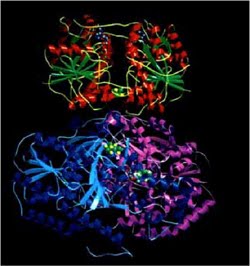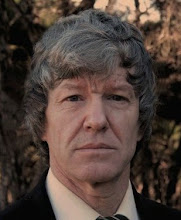Genetic researchers have long dismissed as 'junk' stretches of DNA that were not genes, a view I always refused to accept. But during the past year it has been found that the 'junk' has been faithfully reproduced generation after generation after generation, thus showing that it has an important function. Nature would not bother to take great pains to replicate junk. Also during the past year other researchers built a simple computer from DNA.
It is therefore obvious that DNA is not what the traditional view would have us believe. To see it only as genes is, literally, like seeing a computer as nothing but program and dismissing the rest as junk. Genes are only part of the story. DNA is far, far more. It is integrated processor, data-storage, program and power-source. It can therefore be seen as intelligent; it has design-intelligence; it is design-intelligence: stored design with the intelligence and power to manufacture it.
That applies not only to DNA: cell-proteins in general are processors. Which explains why the folding that is so critical alters the way that protein processor functions. Folding affects the shape and therefore the function of the processor; it also affects its internal power-level because it alters the electrical potential of the molecule. When the processor and its level of self-power are different the function of the molecule are different.
It has been found that bacteria communicate with chemicals and by that means intelligently co-ordinate their actions. Therefore DNA and other complex proteins also communicate using lesser chemicals, thus forming processing molecular networks, just as computers communicate with packets of data over networks; there is also electrical communication. Thus there is an intelligent processing network at the level of complex bio-molecules, literally making the cell; on top of that is the network of cells, together making up simple organisms, or organs in higher organisms; on top of that is the network of organs together making up the organism.
A computing analogy is that the complex molecules are the components in a computer, with DNA being the CPU; on top of that computers are formed into local networks; on top of that they are formed into the global Internet.
DNA is not only a programmed computer, complete with memory, data-storage and a power-source, it is self-programming, self-improving, exploring, like T-cells, for a better 'fit' to the external needs of the organism.
The few-percent different in genetic instructions between chimps and humans (although significant in such a huge total) is therefore only a fraction of the story. The processors are different, so the resulting organisms are different. A different design-intelligence, a different level of processing power, implements a different design. The DNA processor of a human being is far more intelligent and complex than the DNA processor of an insects or bacteria, so we are far more intelligent and complex. Even when the same code or data is processed the result is different. To adapt Marshall McLuhan, the processing is the organism.
That is true not only of the making on an organism it is also true of its behaviour and activities. For instance, a bird is not taught how to build a nest or rear young, etc.. It just knows, because its molecular processing informs its actions. There is behavioural intelligence, stored behavioural design at molecular level.
The same applies to memory--indeed to thinking in general. It is essentially molecular. Above that is the neural level, the functioning of neurons; above that is the functioning of the brain, all the neurons acting in concert, firstly in the sub-networks that are the discrete areas of the brain, then in the complete network.
A thought or a memory may thus be a unique network of neurons identified by marker proteins stored only in that neural set. Then to recall the memory would just be a matter of re-establishing the same network by establishing the start of it, or sufficient of it to begin the trace, then that starter neuron would interrogate all the ones linked to it to establish which have that protein, and so on, till that entire 'thought-net' has been searched out, retrieved and be firing. Any neuron could be in thousands of thought-nets, each very different, because each cell can have thousands of different proteins; it would just be linked to a different neural set characterised by the marker protein unique to that set. Modification of a thought or memory would be then the addition or deletion of neurons from a thought-net by making or eliminating the relevant marker neuron specific to that net.
The only argument left between the ungodly and the godly is whether that fundamental DNA and molecular intelligence arose spontaneously from nothing or was put there. If put there, was it processed into being by the quantum computer called Earth (Gaia, if you prefer), a subset of the quantum computer called the Universe? Or was it all put there by God?
But both sides of that puerile ID argument (i.e., 'intelligent design' versus evolution) have to accept that absolute proof, and also therefore absolute disproof, of the ultimate source are beyond the reach of human science. Neither side can absolutely prove the existence of anything, not even their own existence.
Relative proof, however, which is knowledge of communication, or knowledge of sensory awareness both internally with oneself and externally with others, is another matter. We all do that every day. And as Winston Churchill neatly put it: Men often stumble over the truth. Most of them manage to pick themselves up and carry on as if nothing had happened.
(Copied from a posting to my EStar blog dated the 3rd of November 2006.)
skip to main |
skip to sidebar



Thoughts on the fundamental logic--i.e., the molecular logic--of life, plus other life items (the first are copied from my EStar blog, from 2006 onwards). The foundation of life is the logic of the atom; built on that is the logic of the molecule; built on that is the logic of the cell; built on that is the logic of the organ; built on that is the logic of the organism.


Popular Posts
-
This article from the online entity of Science , published by the American Association for the Advancement of Science, is yet more proof of ...
-
THE REAL ORIGIN OF SPECIES — BIODEVELOPMENT — by NOBILANGELO CERAMALUS (pronounced noble- arn -jillo kerra- mar -liss) Member of the Americ...
-
Using very fine electrodes, researchers have revealed some of the astonishing processing-power of a single human neuron. Full story at ht...
-
Bio-molecules are network processors. A cell is a collection of molecular network processors. The individual processing is affected by the b...
-
This article gets close to saying what this blog has been saying for years . Bio-molecular logic and processing operates over the aeons to ...
-
As this blog has been saying for years, the so-called 'junk' DNA is not junk. To use computer terms, DNA is CPU, RAM, disk drive, o...
-
The process of transcribing DNA instructions into proteins has now been found to be a lot smarter than previously imagined. A detailed com...
Blog Archive
-
▼
2008
(46)
-
▼
January
(11)
- MAGNETIC CONTROL OF MOLECULAR MACHINES
- THE LOGIC AND TRUTH OF BEING
- MACHINES OF BEING
- THE PHYSICAL AND SPIRITUAL MEETING-POINT
- BACTERIA ARE SMARTER THAN PEOPLE
- ONE NEURON IS A LOT OF POWER
- INSIGHT ON THE WORKING OF THE BRAIN NOW PROVED
- YET MORE PROOF OF THE TRUTH ABOUT DNA
- DNA PROVED MORE THAN WAS THOUGHT
- POLITICAL CORRECTNESS IS PSYCHOLOGICAL ABUSE
- DNA IS FAR MORE THAN WAS THOUGHT
-
▼
January
(11)
Total Pageviews
NOTE ON TOTAL PAGEVIEWS
Blogger's statistics have not been operating since the start of this blog. Only since mid 2009.
About Me

- Nobilangelo
- My Christian name is pronounced 'noble-arn-jillo' (i.e., both o's are long, so the first two syllables rhyme with 'noble' not 'hobble'--yes, I know that's obvious, because there's only one 'b' between the 'o' and the 'i', but some people seem to see two b's, hence the English lesson). My surname is pronounced kerra-marliss. I was born, bred and educated in New Zealand, except for an international systems-engineer's course in San Antonio, Texas. I am born-again Christian, a thinker with a very practical turn of mind, a scientist with a particular interest in planet-friendly energy and neuroscience, an engineer (mechanical, industrial and IT systems), an inventor, a Member of the American Association for the Advancement of Science, a writer and poet, a naturist, a designer in different fields, an arranger and composer of symphonic music, a multi-award-winning IT journalist, a photographer, and a practitioner at various times in other hands-on fields including building, metalwork, woodwork, stained-glass and landscaping.